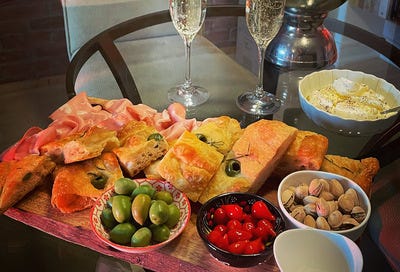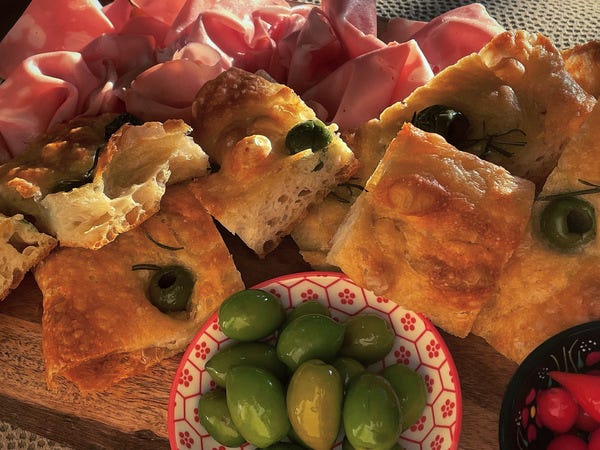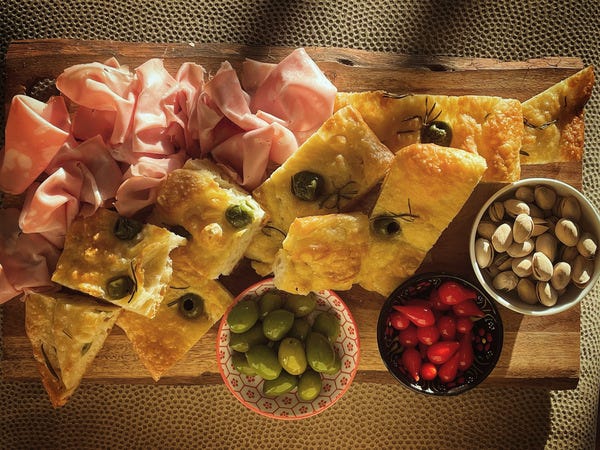A friend stopped by for drinks the other day.
I had spent the afternoon teaching Wine for Beginners at George Brown College, a three-hour class that ends at 4 p.m. With my friend scheduled to come by for five, I really didn’t have any time to get fancy.
The day before, I put a bottle of bubbly in the fridge, and began the ooey, gooey, wildly satisfying, tactile process of making focaccia. It’s way easier than you think, and the recipe for that is below. Of course, if you doubt your baking skills (you really shouldn’t), or are simply flat out of time, you can always buy it along with the other snacks. Apéro is about joy, not judgement.
The below menu is delightfully elegant in its simplicity.
Mortadella – Hailing from Bologna, it is absolutely worth it, maybe even required, to get the thinly sliced, good quality, Italian mortadella. And the best news is that it’s cheap as chips, so you might as well get the good stuff.
Burrata – The IT girl of every cheeseboard. A drizzle of olive oil and a sprinkling of Maldon salt is all that’s needed, but you could always top it with pickled onions or celery for a little extra wink of flavour and crunch.
Pistachios – salted and roasted, shells on
Focaccia – I like to use rosemary and olives as toppings, but you can use whatever you like. Obviously.
To drink: Brut (dry) bubbly. Nothing is faster, easier, and more celebratory than popping the cork on some good sparkling wine. And there’s something so inviting about flinging open the door and greeting your friends with a cold glass of fizz. If you wanted to up the ante by adding a splash of Limoncello or Elderflower liqueur, I’m certainly not going to stop you.
Focaccia
A few years ago, I took a pizza and dough-making course, led by the magnificently talented Ema Costantini. Focaccia was naturally part of the curriculum.
I’m not a baker at heart. I struggle with exact measurements, and I am forever exasperated when recipes come with instructions such as “knead to incorporate, but do not over-knead.”
Luckily for me, focaccia is a forgiving recipe that, really, seems to be able to withstand under- or over-kneading.
Cherry picking between what I considered the best (or easiest) parts of Ema’s recipes, along with cookbook author Alexandra Stafford, and someone who goes by the name @_lacebakes_ on Instagram, “my” recipe is the result of that culinary Venn diagram.
If you attempt this to only so-so results, don’t get discouraged. Focaccia is a very well hydrated dough, and as such can be a bit of a beast to wrestle into submission. Keep trying, takes notes, and enjoy the journey.
Makes: 9x13 baking tray
Chef level: Moderate
Special equipment: digital scale
Ingredients
8g Instant yeast
1tsp Honey
2c Lukewarm water
2tsp Kosher salt
4c/500g Bread flour
1c Extra Virgin Olive Oil, divided
Olives
Rosemary
How to Make It:
Yeast can be finicky – mix with water that’s too hot and they die off, too cold and nothing happens. To get a good temperature, mix ¾ hot tap water with ¼ cold and you should get a tepid temperature that pleases the yeast.
In a large bowl, add instant yeast, honey, and the lukewarm water.
Give it 10 minutes, you should see lots of frothing. If not, you’re yeast is dead or on the way out, so go get new yeast and start again.
Add in the salt and 1 Tbsp of oil to the yeast mixture.
Add in the flour, a little at a time, and work it into the water. You will have sticky, gloppy mess, and, unbelievably, this is what you want.
Leave it on the counter, cover with a clean kitchen towel and set aside for 10 mins.
With wet hands, so the dough doesn’t stick, grab one side of the dough and pull it up and over the rest of the dough (so taking the left side and folding it over the right side.) Turn the bowl a ¼ turn and repeat this stretch and pull over until you completed all four sides.
Cover with the towel and leave to rest on the counter for 30 minutes. You will repeat the stretch and pull 4 times, leaving the dough to rest 30 minutes between each set, for a total of two hours.
When your final stretch and pull is complete pour another 1 Tbsp oil over the dough, gently smooth the oil across the surface, cover the bowl with plastic wrap and place in the fridge to rest overnight, or up to 24 hours.
The next day, your dough should have risen impressively – likely pushing itself against plastic wrap in a mighty mushroom. You will be so pleased with yourself.
Oil a 9 x 13 baking tray and place a sheet of parchment paper on it (the oil will help the paper from sliding around.) Pour another 1 Tbsp of olive oil on the parchment paper.
Take your dough out of the fridge, remove the plastic wrap, and gently pour it onto the parchment paper. Fold the dough in three pieces, like a burrito, and allow it to rest, covered with another baking pan*, for 2-3 hours on the counter (the hotter your kitchen the less time your will need.)
When you come back the dough should have risen again and spread to nearly the corners of the baking tray. If it hasn’t, simply wet your hands again and gently pull it into the corners the best you can. Don’t sweat it if it doesn’t fully reach the corners.
Now using your fingertips, gently dimple the dough. This is the best part of making focaccia.
Pour even more olive oil over the top, sprinkle with Maldon or sea salt, and any garnish you like. I usually use olive and rosemary but use your imagination. Just make sure toppings are well oiled so they don’t burn while baking.
Place your baking tray in a 430°F oven and bake, turning the tray once to ensure even baking, for about 30 minutes, until golden and the outside is crisp and inside soft and chewy.
Wine Pairing:
As I said above, I think a brut bubbly, whether that be Prosecco or a French sparkling wine is perfect for apèro, but if you are craving something that’s a little more niche, try a Limoncello Basil Spritz in summer, or a Kir Royale in winter.







